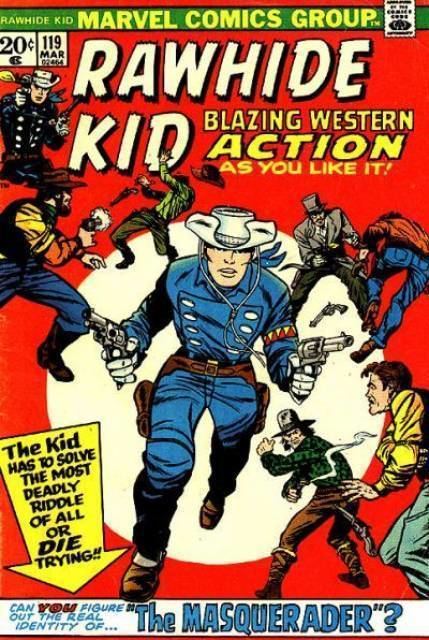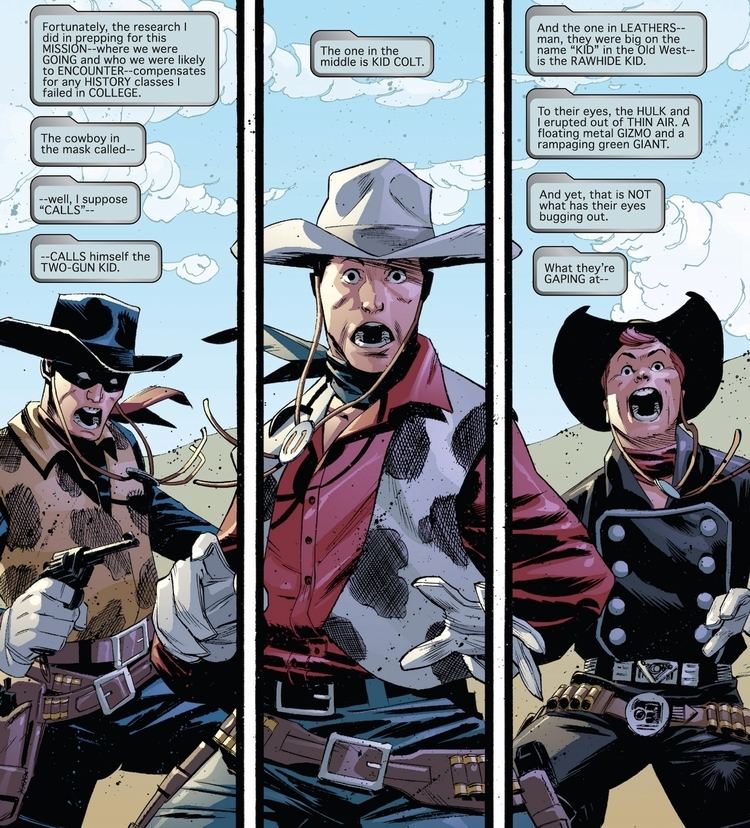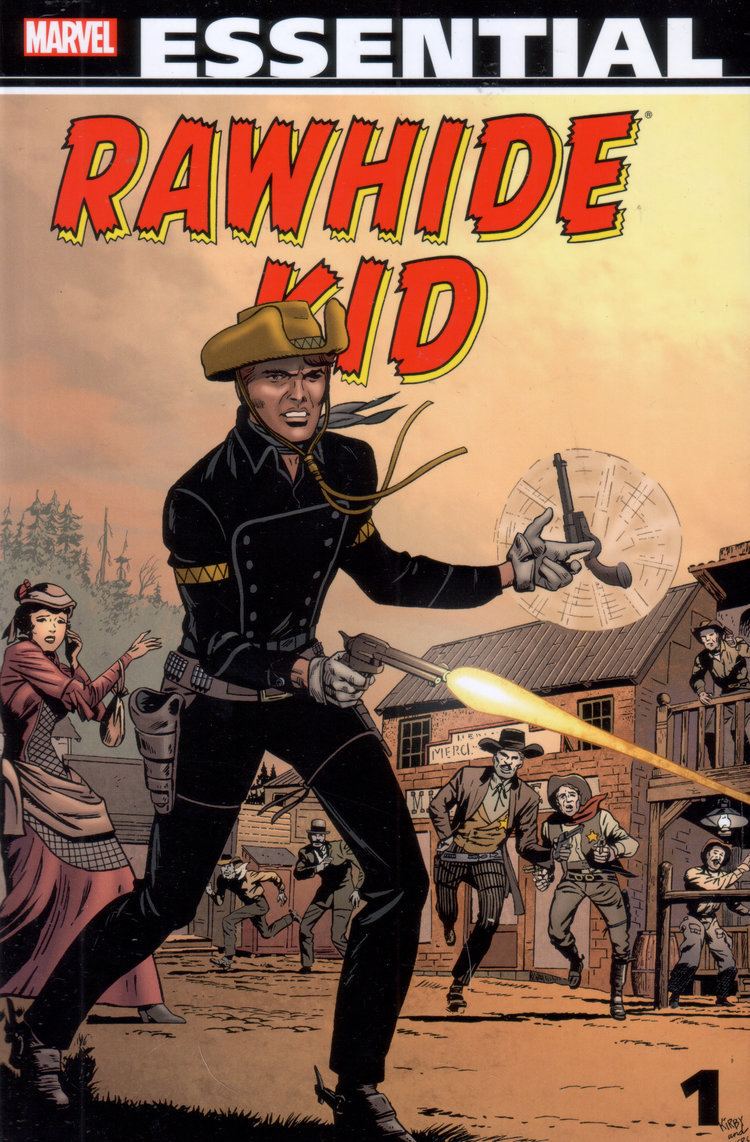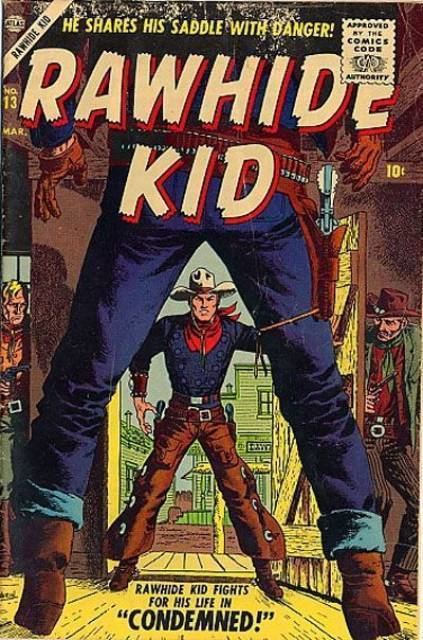Alter ego Johnny Bart Fictional universe Marvel Universe | Notable aliases Johnny Clay | |
 | ||
Team affiliations AvengersWest Coast AvengersThe Sensational Seven Publisher Atlas ComicsMarvel Comics First appearance Rawhide Kid #1 (March 1955) Similar Kid Colt, Two‑Gun Kid, Outlaw Kid, Ringo Kid, Gunhawks | ||
Rawhide kid 18 wolf waco strikes
The Rawhide Kid (real name: Johnny Bart, originally given as Johnny Clay) is a fictional Old West cowboy appearing in American comic books published by Marvel Comics. A heroic gunfighter of the 19th-century American West who was unjustly wanted as an outlaw, he is one of Marvel's most prolific Western characters. He and other Marvel western heroes have on rare occasions guest-starred through time travel in such contemporary titles as The Avengers and West Coast Avengers. In two mature-audience miniseries, in 2003 and 2010, he is depicted as gay.
Contents
- Rawhide kid 18 wolf waco strikes
- The rawhide kid 17 beware the rawhide kid
- Atlas Comics
- Marvel Comics
- 2000s treatments
- Fictional character biography
- Marvel Zombies
- Secret Wars
- Collected editions
- References

The rawhide kid 17 beware the rawhide kid
Atlas Comics

The Rawhide Kid debuted in a 16-issue series (March 1955-Sept. 1957) from Marvel's 1950s predecessor, Atlas Comics. Most of the covers from the series were produced by highly acclaimed artists, generally either Joe Maneely or John Severin, but also Russ Heath and Fred Kida. Interior art for the first five issues was by Bob Brown, with Dick Ayers at the reins thereafter.
Marvel Comics

After a hiatus, the Rawhide Kid was revamped for what was now Marvel Comics by writer Stan Lee, penciler Jack Kirby and inker Ayers. Continuing the Atlas numbering with issue #17 (Aug. 1960), the title now featured a diminutive yet confident, soft-spoken fast gun constantly underestimated by bullying toughs, varmints, owlhoots, polecats, crooked saloon owners and other archetypes squeezed through the prism of Lee & Kirby's anarchic imagination. As in the outsized, exuberantly exaggerated action of the later-to-come World War II series Sgt. Fury and His Howling Commandos, The Rawhide Kid was now a freewheeling romp of energetic, almost slapstick action across cattle ranches, horse troughs, corrals, canyons and swinging chandeliers. Stringently moral, the Kid nevertheless showed a gleeful pride in his shooting and his acrobatic fight skills — never picking arguments but constantly forced to surprise lummoxes far bigger than he.

Through retcon, bits of and pieces of the Atlas and Silver Age characters' history meshed, so that the unnamed infant son of settlers the Clay family, orphaned by a Cheyenne raid, was raised by Texas Ranger Ben Bart on a ranch near Rawhide, Texas. Older brother Frank Clay, captured by Native Americans, eventually escaped and became a gambler, while eldest brother Joe Clay became sheriff of the town of Willow Flats; neither were in the regular cast, and each died in a guest appearance. Shortly after Johnny's 18th birthday, Ben Bart was murdered; Johnny, an almost preternaturally fast and accurate gunman, wounded the killers and left them to be taken into custody. A later misunderstanding between the Kid and a sheriff over a cattle rustler the Kid wounded in self-defense led to the hero's life as a fugitive.

Kirby continued as penciler through #32 (Feb. 1963), while helping to launch the Fantastic Four, the Hulk and other iconic characters of the "Marvel revolution". He drew covers through issue #47. Issues #33-35 were drawn by EC Comics veteran Jack Davis — some of the last color comics he would draw before gaining fame at the black-and-white, satirical comics magazine Mad. After several issues by Ayers, followed by a single issue by long-time Kid Colt artist Jack Keller, Larry Lieber, Lee's writer brother, began his nine-year run as the series' writer-artist, which lasted over 75 issues from 1964–1973. Lieber said in 1999,

I don't remember why I wanted to do it, particularly. I think I wanted a little more freedom. I didn't do enough of the superheroes to know whether I'd like them. What I didn't prefer was the style that was developing. It didn't appeal to me. ... Maybe there was just too much humor in it, or too much something. ... I remember, at the time, I wanted to make everything serious. I didn't want to give a light tone to it. When I did Rawhide Kid, I wanted people to cry as if they were watching High Noon or something. ... I'm a little unclear about leaving the superheroes and going to Rawhide Kid. I know that at the time I wanted — what's the expression? — a little space for myself or something, and I wanted to do a little drawing again.
By 1973, as superheroes became increasingly ascendant, The Rawhide Kid became primarily a reprint title, though often bearing new covers by such prominent artists as Gene Colan, Gil Kane and Paul Gulacy. It ended publication with issue #151 (May 1979). This initial volume of the series included a single annual publication, cover-titled Rawhide Kid King-Size Special (Sept. 1971). As well, reprints, including many Jack Kirby-drawn stories, appeared in the 1968-1976 title The Mighty Marvel Western.
The Rawhide Kid later appeared as a middle-aged character in a four-issue miniseries, The Rawhide Kid vol. 2 (Aug.-Nov. 1985), by writer Bill Mantlo and penciler Herb Trimpe.
2000s treatments
The Rawhide Kid reappeared in the four-issue miniseries, Blaze of Glory (Feb.-March 2000; published biweekly), by writer John Ostrander and artist Leonardo Manco, and a 2002 four-issue sequel, Apache Skies, by the same creative team.
In contrast to the character's previously depicted appearance — a small-statured, clean-cut redhead — these latter two series depicted him with shoulder-length dark hair, and wearing a slightly less stylized, more historically appropriate outfit than his classic one.
A controversial five-issue miniseries, Rawhide Kid vol. 3 (April–June 2003), titled "Slap Leather" was published biweekly by Marvel's mature-audience MAX imprint. Here the character was depicted as homosexual, with a good portion of the dialogue dedicated to innuendo to this effect. The series, which was written by Ron Zimmerman, and drawn by artist John Severin, was labeled with a "Parental Advisory Explicit Content" warning on the cover. Series editor Axel Alonso said, "We thought it would be interesting to play with the genre. Enigmatic cowboy rides into dusty little desert town victimized by desperadoes, saves the day, wins everyone's heart, then rides off into the sunset, looking better than any cowboy has a right to."
A sequel miniseries, The Rawhide Kid vol. 4 (Aug.-Nov. 2010), rendered with a subtitle on covers as Rawhide Kid: The Sensational Seven, found the Kid and his posse (consisting of Kid Colt, Doc Holliday, Annie Oakley, Billy the Kid, Red Wolf and The Two-Gun Kid) track the villainous Cristo Pike after Pike and his gang kidnap Wyatt and Morgan Earp. The sequel was again written by Zimmerman, with Howard Chaykin taking over as artist.
Fictional character biography
Johnny Clay was born in 1850 and orphaned as an infant, adopted by Ben Bart. In 1868 his "uncle" was murdered and he left the family ranch. In 1869 he became a wanted man. In 1870 he fought the Living Totem. In 1872 he captured the costumed Grizzly with the help of the Two-Gun Kid. He joined Kid Colt to defeat Iron Mask. In 1873 he met the Avengers In 1874 he met Doc Holliday. In 1875 he helped the Black Panther with Kid Colt and the Two-Gun Kid. In 1876 Rawhide Kid, Kid Colt and Two-Gun Kid faced Red Raven, Iron Mask and the Living Totem with the help of the Avengers. In 1879 he met the Apache Kid. Subsequently he became a performer for Buffalo Bill's Wild West Show where he remained until 1885. In 1897 he took an understudy under his tutelage.
Marvel Zombies
When a meteorite landed on Earth-483, it emitted radiation that resurrected all of the corpses, including Rawhide Kid's, buried in the adjacent Boot Hill as "Romero-type" zombies. Rawhide Kid and the other reanimated gunslingers invade a nearby town, and are destroyed by Hurricane.
Secret Wars
Rawhide Kid appears as a member of the Thor Corps whose jurisdiction is a Wild West-themed domain of Battleworld called the Valley of Doom. He arrested that region's version of Hank Pym for illegal possession of adamantium, which led to Pym being banished to another domain called Perfection.
